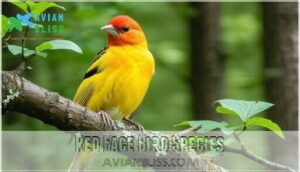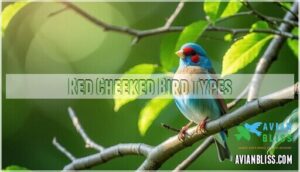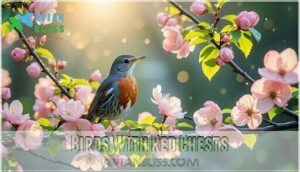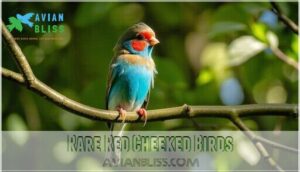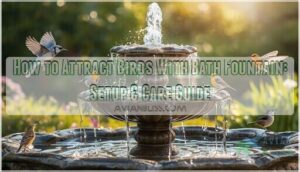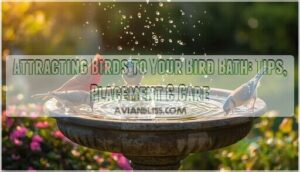This site is supported by our readers. We may earn a commission, at no cost to you, if you purchase through links.
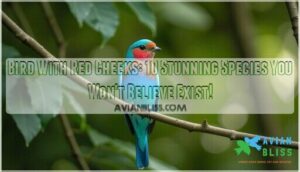
The Red-cheeked Cordon-bleu showcases vibrant crimson patches that pop against its blue plumage, while the Red-whiskered Bulbul sports distinctive red markings below its eyes.
Many parrot species, including certain cockatoos and parakeets, flash their rosy cheek panels when excited or during courtship displays.
These colorful markings aren’t just for show—they’re essential visual signals for mate attraction and territorial claims.
Think of these red cheeks as nature’s way of helping birds stand out in a crowd.
Wait until you see how these flashy features vary across different habitats worldwide.
Table Of Contents
- Key Takeaways
- Birds With Red Cheeks
- Red Face Bird Species
- Red Cheeked Bird Types
- Birds With Red Chests
- Rare Red Cheeked Birds
- Frequently Asked Questions (FAQs)
- What bird has a red face?
- What bird has a red head?
- What bird has a red chest?
- What does it mean if a bird has red cheeks?
- What birds have red beaks?
- What birds are red-breasted?
- What bird has red cheeks?
- How rare is it to see a Northern Flicker?
- Is a cockatiel a good starter bird?
- What states do northern flickers live in?
- Conclusion
Key Takeaways
- You’ll find birds with red cheeks across various families including finches, parrots, woodpeckers, and bulbuls, with the Red-Cheeked Cordon-Bleu Finch and Red-Whiskered Bulbul being notable examples.
- Red cheek markings aren’t just for show—they serve as essential visual signals for mate attraction, species identification, and territorial claims in the wild.
- Some species display sexual dimorphism with males having brighter red cheeks, while others like the Red-Faced Warbler show similar coloration in both males and females.
- Conservation efforts are crucial for certain red-cheeked species like the Palm Cockatoo, which was listed as endangered in Queensland as of November 2021 due to habitat loss.
Birds With Red Cheeks
You’ll be amazed at the variety of birds that sport vibrant red cheek patches, from the tiny Red-Cheeked Cordon-Bleu Finch of Africa to Australia’s impressive Palm Cockatoo.
These distinctive facial markings aren’t just for show – they help with species identification and often play a pivotal role in courtship displays.
Nature’s crimson signatures on feathered faces—stunning visual passports that unlock the secrets of love and identity.
Red-Cheeked Cordon-Bleu Finch Characteristics
Within the savannas of Africa, you’ll find the Red-Cheeked Cordon-Bleu Finch, a tiny bird with vibrant red cheeks that’s guaranteed to catch your eye.
These small finches weigh just 9.9g and thrive in warm habitats around 77°F.
Their sky-blue plumage looks like a piece of heaven took flight
- Males sport striking red cheeks that pop like nature’s blush
- Their peaceful chirps sound like tiny wind chimes
- They dance together during courtship, melting hearts everywhere
- Their tiny size makes you want to protect these delicate creatures
- They have a unique way of interacting with their environment
These finches have a varied cordon bleu finch price depending on the vendor, which can be a significant factor for those interested in learning more about the courtship and habitat of these birds, and how to care for them in a way that preserves their natural behavior.
Red Whiskered Bulbul Features
You’ll often spot the Red Whiskered Bulbul by its distinctive red spots on each cheek.
These social birds showcase a dark brown and white plumage with a black crest atop their head.
Native to Southern Asia, their diet includes fruits and insects.
Their cheerful, bubbly song fills their woodland habitat.
When they puff up their feathers, those rosy cheeks become even more prominent.
Some birds, like the Acorn Woodpecker, also display bold red caps, which can be a notable visual feature.
Cockatiel Red Cheek Markings
When you look at a cockatiel, you’ll notice distinctive red cheek markings that make this bird with red cheeks instantly recognizable.
These vibrant red dots aren’t just for show—they’re linked to Cheek Spot Genetics and can vary in intensity based on Diet and Color intake.
As your cockatiel ages, these spots may change, serving as Health Indicators. Some parakeet enthusiasts specifically breed for Mutation Variations that enhance these gorgeous red cheeks.
Owners sometimes seek products for cockatiel cheek enhancement.
Palm Cockatoo Red Facial Patches
The Palm Cockatoo’s red facial patches aren’t just for show – they’re actually bare skin areas that change color like chameleons.
You’ll notice these distinctive patches flush darker when the bird is excited or alarmed, thanks to increased blood flow.
This unique structure serves display purposes during courtship and communication.
These Australian birds, with their ebony eyes above the bright red cheeks, develop these patches as they mature.
Red-Crowned Parakeet Cheek Dots
While the majestic Palm Cockatoo shows off dramatic red patches, the Red-Crowned Parakeet keeps things subtle with its distinctive red cheek dots.
These rosy cheeked birds display fascinating dot variation that’ll capture your attention.
When observing these red cheeked parakeets, you’ll notice:
- Dot size varies based on age and genetics
- Color intensity deepens during mating season
- Dots develop gradually through specific stages
- Males typically display brighter dots than females
- Dot patterns serve as unique identifiers (like fingerprints) that help in recognizing individual birds with distinctive red cheek dots and fascinating dot variation.
Red Face Bird Species
You’ll find nature’s most striking red-faced birds displaying vibrant crimson hues across their facial feathers, from the Cardinal-like Pyrrhuloxia with its yellow beak to the Western Tanager with its brilliant red face against a yellow body.
These colorful species use their distinctive facial markings for everything from attracting mates to establishing territory in their native habitats, which is a crucial aspect of their behavior and social structure, showcasing their unique facial feathers.
Pyrrhuloxia Red Face and Crest
You might mistake the Pyrrhuloxia for a Northern Cardinal, but this "Desert Cardinal" sports a distinctive red face and crest that’ll catch your eye.
Native to the US and Mexico, these birds have a unique yellow beak and red facial features that blend beautifully with their gray body.
Their red coloration varies subtly across regional variations, making Pyrrhuloxia identification a rewarding challenge for birdwatchers.
Western Tanager Red Face and Yellow Body
While the Pyrrhuloxia impresses with its subtle charm, the Western Tanager steals the show with its fiery red face and sunshine-yellow body.
This colorful bird measures 6-7 inches in length and thrives in western pine forests.
You’ll spot male tanagers flashing black wings against their bright plumage. Their Tanager diet consists mainly of insects like wasps and ants during nesting season, with berries and fruits mixed in whenever possible.
The female Western Tanager guides nest-site selection in open forests.
Red-Faced Barbet Vivid Red Coloring
Have you ever spotted the striking Red-faced Barbet in African savannas?
This colorful bird showcases vivid red coloring on its face and around the eye, contrasting beautifully with its black body.
You’ll find this frugivorous beauty in Burundi, Rwanda, Tanzania, and Uganda’s dry and moist savanna habitats.
Its diet consists mainly of figs and fruits, though it occasionally flycatches for insects with remarkable precision.
Red-Faced Warbler Male and Female Differences
While the Red-faced Barbet dazzles with its vibrant coloration, the Red-faced Warbler offers its own surprising twist – unlike many bird species, both males and females sport striking crimson faces!
- Males display vivid red faces with gray bellies and wings
- Females have slightly more orangish-red markings but remain nearly as bright
- Color intensity varies among individuals, possibly related to age
- Males attract mates with high-pitched, charming songs
You’d be hard-pressed to tell these redfaced beauties apart at first glance!
The female builds an open cup nest using grasses and bark.
Red Cheeked Bird Types
You’ll find birds with red cheeks across various families, including parrots, finches, woodpeckers, and bulbuls that display this striking facial feature.
From the tiny Red-Cheeked Cordon-Bleu Finch to the impressive Palm Cockatoo, these birds showcase nature’s artistic touch with their vibrant cheek patches that often look like they’re blushing after hearing a bird compliment, highlighting their unique facial feature.
Parrot Species With Red Cheeks
Parrots with flame-kissed cheeks are among the most eye-catching birds in the avian world.
You’ll find this striking red coloration in several species, including the Red-crowned Parakeet and Palm Cockatoo.
Cockatiel mutations also display vibrant red cheek patches due to specific genetic factors.
Finch Species With Red Cheeks
Among the feathered gems of the finch world, several species flash distinctive red cheeks.
The Red-cheeked Cordon-Bleu finch dazzles with vibrant red dots against its blue plumage, while male House Finches display rosy red around the face and upper breast.
Purple Finches aren’t actually purple but show more red on the face than their House Finch cousins.
Captive breeding of these colorful finches requires special attention to their diet differences.
Woodpecker Species With Red Cheeks
While finches show delicate red cheek markings, woodpeckers often display more dramatic facial coloration.
You’ll be amazed by these red-cheeked drummers:
- Red-Bellied Woodpeckers sport white faces with subtle brown cheeks
- Red-Headed Woodpeckers have striking all-red heads with brown cheeks
- Lewis’s Woodpecker shows off a bold red face
- Cream-colored Woodpeckers (males) feature Pikachu-like red cheeks
- Flicker subspecies often display unique red cheek patterns
These forest drummers adapt to various woodpecker habitats across North America.
Acorn Woodpeckers, known for their clown-like faces, engage in cooperative breeding habits, which is a unique behavior that showcases their social structure and ability to thrive in different environments, making them a fascinating subject to study, especially their cooperative breeding habits.
Bulbul Species With Red Cheeks
Have you ever spotted a Red-Whiskered Bulbul with its distinctive red cheek patch? These medium-sized songbirds are easily identified by their pointed black crest and bright red spots beneath each eye.
Native to Southern Asia, bulbuls inhabit forests, gardens, and urban areas. They’re omnivorous, enjoying fruits, insects, and nectar.
Despite their adaptability, some bulbul species face conservation challenges due to habitat loss. You’ll often hear their cheerful calls before seeing their red cheeks.
Birds With Red Chests
You’ll find that birds with red chests stand out brilliantly in any backyard or forest setting, with species like the American Robin and Painted Bunting displaying stunning crimson plumage that signals to potential mates.
When you spot these ruby-chested beauties, you’re witnessing nature’s perfect combination of practical design and visual splendor.
The vivid red coloration serves both as camouflage among berries and as an advertisement of genetic fitness.
American Robin Red Chest and Belly
You’ve probably spotted an American Robin hopping across your lawn.
This familiar bird’s most distinctive feature is its warm, rusty red chest and belly.
Robin plumage varies between adults and juveniles—young Robins have speckled breasts until maturity.
Their diet consists mainly of earthworms and berries, which they hunt for in gardens and woodland edges.
Robin behavior includes their characteristic head-tilting as they listen for worms underground.
Painted Bunting Red Underparts
While American Robins showcase their rusty red chests, the Painted Bunting takes red coloration to spectacular heights.
You’ll find these summer residents along coastal habitats from the Carolinas to Florida.
Males display brilliant red underparts, complemented by blue heads and green backs.
Their vibrant plumage variations make them North America’s most colorful songbirds.
Despite their beauty, Painted Bunting conservation efforts remain important due to habitat preference challenges and population declines.
Red Siskin Red Chest and Dark Head
The Red Siskin sports a striking combination of vibrant red chest contrasting with its dark head.
You’ll find this small beauty in tropical habitats across Venezuela, where habitat destruction threatens its survival.
Its red coloration varies slightly between individuals, highlighting plumage variation within the species.
Breeding habits rely on genetic diversity, making siskin conservation efforts essential.
When you spot one, you’re witnessing one of nature’s increasingly rare red-chested birds!
Elegant Trogon Orange-Red Belly
Spotting an Elegant Trogon’s vibrant orange-red belly is a real treat for North American bird enthusiasts.
This stocky, potbellied bird is larger than a robin and makes its home in forested canyons of the southwest.
You’ll find these birds perching quietly before darting out to catch insects or fruit.
They’re secondary cavity nesters, relying on woodpeckers for their homes, and their diet consists of berries, grasshoppers, and other small animals.
Rare Red Cheeked Birds
You’ll be amazed at the rare red-cheeked birds hidden in remote corners of our planet, from the critically endangered Palm Cockatoo of Australia to the vibrant Red-Cheeked Cordon-Bleu Finch of Africa.
These distinctive birds with their splashes of crimson on otherwise ordinary faces aren’t just beautiful to look at—they’re living treasures that showcase nature’s artistic flair in unexpected places, highlighting the rare red-cheeked birds as a unique wonder.
Northern Flicker Red Cheek Markings
While birds with red chests might catch your eye, the Northern Flicker’s cheek markings are truly something special.
This unique woodpecker showcases stunning color pattern variations between its two main subspecies.
The differences between Redshafted and Yellowshafted Flickers will leave you amazed:
- Western Redshafted Flickers have prominent red cheek patches
- Eastern Yellowshafted Flickers display tan faces with red nape crescents
- Hybridization patterns create stunning blends where ranges overlap
- Genetic factors control these markings with only 0.01% DNA difference
- Cheek development varies dramatically despite nearly identical genomes
Some species, like the Acorn Woodpecker, display bold red caps.
Red-Cheeked Cordon-Bleu Finch Habitat
Unlike the Northern Flicker, the charming Red-Cheeked Cordon-Bleu finch calls sub-Saharan Africa home.
You’ll find these tiny birds with red cheeks throughout central and eastern African habitats.
| Region Type | Nesting Locations | Water Sources |
|---|---|---|
| Grasslands | Thorn Bushes | Seasonal Pools |
| Savannas | Village Areas | Water Holes |
| Dry Bush | Thick Vegetation | Stream Edges |
These finches thrive in drier climates where they build domed nests and often form small, sociable flocks.
You can find Cordon-Bleu related products online, which is a great way to learn more about these charming birds and their natural habitats.
Red Whiskered Bulbul Native Range
You’re exploring the Red Whiskered Bulbul’s native range, which spans India, Sri Lanka, and China.
Key facts include:
- Native to tropical Asia
- Introduced to other areas
- Found in various habitats
- Has established populations worldwide
They are classified as a species of least concern due to their widespread presence.
Palm Cockatoo Conservation Status
The majestic Palm Cockatoo faces serious threats to survival.
This rare bird species was officially listed as ‘endangered‘ in Queensland as of November 2021, upgrading from its ‘vulnerable’ status nationally.
Habitat loss remains the primary concern, with population trends showing a projected 20-29% decline over the next 47 years.
Conservation efforts include CITES protection and specialized breeding programs, though you’ll need luck to spot this striking cockatoo in the wild.
Frequently Asked Questions (FAQs)
What bird has a red face?
Several birds sport red faces, including the Red-faced Barbet, Red-faced Warbler, Red-masked Parakeet, Pyrrhuloxia, and Western Tanager. You’ll recognize these distinctive species by their vibrant crimson facial plumage.
What bird has a red head?
You’ll spot red-headed woodpeckers with their striking crimson caps. Northern Cardinals flaunt brilliant red heads too. Red-headed Finches, Pyrrhuloxias, and Western Tanagers also sport reddish craniums that’ll catch your eye.
What bird has a red chest?
Like a ruby nestled among feathers, you’ll find red chests on American Robins, Northern Cardinals, and Cassin’s Finches. The Pyrrhuloxia and Red Siskin also display striking red chest plumage.
What does it mean if a bird has red cheeks?
When you spot a bird with red cheeks, it’s typically a sign of species identification or male display.
Red facial patches help birds attract mates and establish territory during breeding season, which can be seen as a key aspect of male display.
What birds have red beaks?
While cardinals dazzle with bright red bills, you’ll also find red beaks on toucans, American oystercatchers, and red-billed tropicbirds. These distinctive features help with feeding, attracting mates, and species identification.
What birds are red-breasted?
You’ll find red-breasted birds in many families including American Robins, Northern Cardinals, and European Robins.
These striking birds sport vibrant red chest feathers that make them easy to spot during your backyard birdwatching adventures.
What bird has red cheeks?
You’ll be amazed by several feathered friends sporting crimson cheeks! The Red-Cheeked Cordon-Bleu Finch, Red-Whiskered Bulbul, and Palm Cockatoo all display striking red patches that make them instantly recognizable.
How rare is it to see a Northern Flicker?
You’re in luck! Northern Flickers aren’t rare at all.
With 10-20 million across North America, they’re common despite declining by about 2% yearly since
You’ll often spot them feeding on the ground.
Is a cockatiel a good starter bird?
Yes, cockatiels make excellent starter birds. They’re friendly, trainable, and not too noisy. You’ll find them relatively low-maintenance compared to larger parrots, and they’ll often bond well with their owners.
What states do northern flickers live in?
Northern flickers live throughout the entire United States, from Alaska to the southern states.
You’ll spot these adaptable woodpeckers in nearly any area with trees, though they prefer open woodlands and forest edges rather than dense forests.
Conclusion
Fascinating feathered friends with red cheeks continue to captivate birdwatchers worldwide.
Whether you’re spotting a Red-cheeked Cordon-bleu in Africa or a Red-whiskered Bulbul in your backyard, these colorful creatures showcase nature’s artistic flair.
You’ll find that birds with red cheeks aren’t just beautiful—they’re remarkable examples of evolution’s role in creating visual signals for mating and territory.
Next time you’re outdoors with binoculars, keep an eye out for these stunning splashes of crimson in the trees.

